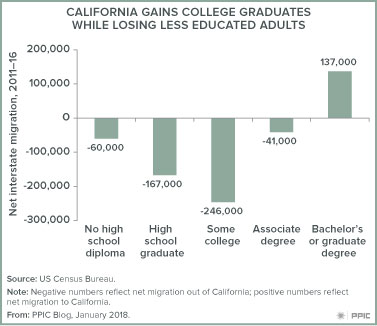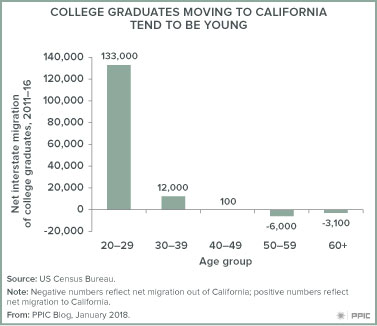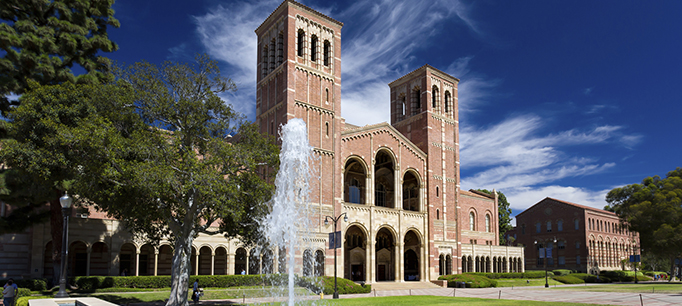Recently released data from the US Census Bureau show that even as California continues to experience large net losses of residents moving out of state, the state is still a net importer of college graduates from other states. This interstate migration pattern—gaining large numbers of college graduates while losing large numbers of less educated adults—is unique among the states. Over the past five years, California has attracted 137,000 more college graduates (adults with at least a bachelor’s degree) from other states than it has sent to those states. For comparison purposes, the University of California (UC) awarded about 250,000 bachelor’s degrees at its nine undergraduate campuses over this same time period. In other words, interstate migration provides California with half as many college graduates as the entire UC system.
 College graduates come to California from all over, but seven states send California substantially more college graduates than they get in return. Between 2011 and 2016, net gains of college graduates from New York (45,000), Illinois (32,000), New Jersey (20,000), Pennsylvania (17,000), Michigan (15,000), Florida (14,000), and Massachusetts (14,000) totaled more than 150,000. California experienced sizable net losses of college graduates to just four states: Texas (-26,000), Oregon (-20,000), Nevada (-14,000), and Arizona (-11,000).
College graduates come to California from all over, but seven states send California substantially more college graduates than they get in return. Between 2011 and 2016, net gains of college graduates from New York (45,000), Illinois (32,000), New Jersey (20,000), Pennsylvania (17,000), Michigan (15,000), Florida (14,000), and Massachusetts (14,000) totaled more than 150,000. California experienced sizable net losses of college graduates to just four states: Texas (-26,000), Oregon (-20,000), Nevada (-14,000), and Arizona (-11,000).
The new migrants to California tend to be quite young. Indeed, college graduates age 20–29 account for almost all of the net gains. (In contrast, California experiences small net losses of older college graduates.) From a labor market perspective, attracting young college graduates is especially advantageous. Young adults with college degrees are at the start of their careers and provide the state with much-needed highly educated workers. The largest gains are in majors that are in relatively high demand in the labor market, including engineering (22,000), social sciences (19,000; mostly economics and political science), computer science (17,000), communications (17,000), biology and health sciences (14,000), and business (13,000).
 The migration of young college graduates to California is a consequence of the state’s growing demand for highly skilled and highly educated workers. But the numbers are not high enough to meet the state’s changing needs. PPIC’s research has shown that by 2030 California will face a shortfall of 1.1 million college graduates. Failing to keep up with the demand for skilled workers could curtail economic growth and limit economic mobility—resulting in a less productive economy, lower incomes, less tax revenue, and increased dependence on the social safety net. Although many college graduates move to California from other states, the most important source of highly educated workers in California are the state’s colleges and universities. Policies and practices to improve college access and completion in the state will ensure that more Californians are able to help create and benefit from a strong economy.
The migration of young college graduates to California is a consequence of the state’s growing demand for highly skilled and highly educated workers. But the numbers are not high enough to meet the state’s changing needs. PPIC’s research has shown that by 2030 California will face a shortfall of 1.1 million college graduates. Failing to keep up with the demand for skilled workers could curtail economic growth and limit economic mobility—resulting in a less productive economy, lower incomes, less tax revenue, and increased dependence on the social safety net. Although many college graduates move to California from other states, the most important source of highly educated workers in California are the state’s colleges and universities. Policies and practices to improve college access and completion in the state will ensure that more Californians are able to help create and benefit from a strong economy.
Read the report Higher Education in California: Addressing California’s Skills Gap
Visit the PPIC Higher Education Center


